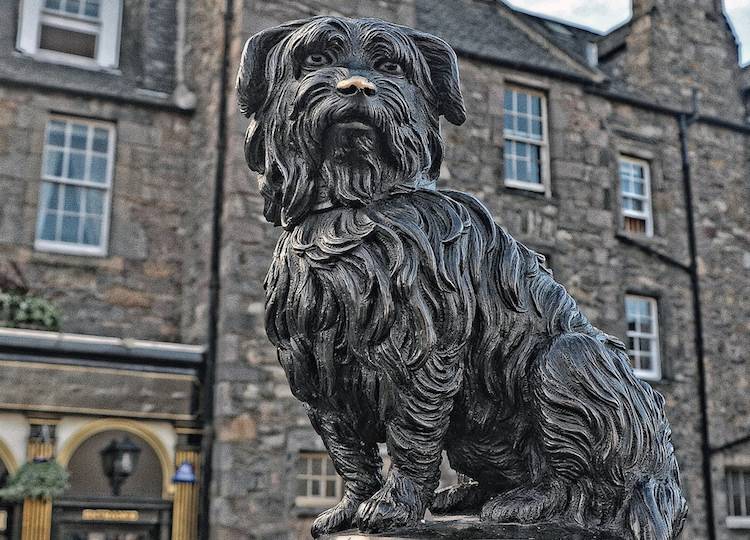Greyfriars Bobby (May 4, 1855 – January 14 1872) was a Skye Terrier who became known in 19th-century Edinburgh for spending 14 years guarding the grave of his owner until he died himself on 14 January 1872. The story continues to be well known in Scotland, through several books and films. A prominent commemorative statue and nearby graves are a tourist attraction.
A year later, the English philanthropist Lady Burdett-Coutts was charmed by the story and had a drinking fountain topped with Bobby’s statue (commissioned from the sculptor William Brodie) erected at the junction of George IV Bridge and Candlemaker Row (opposite the entrance to the churchyard) to commemorate him.
Several books and films have since been based on Bobby’s life, including the novel Greyfriars Bobby (1912) by Eleanor Atkinson and the films Greyfriars Bobby (1961) and The Adventures of Greyfriars Bobby (2006).

The accuracy of stories of Greyfriars Bobby has been challenged many times: for instance, in Forbes Macgregor’s Greyfriars Bobby: The Real Story, at Last, Jan Bondeson’s Greyfriars Bobby: The Most Faithful Dog in the World, and Richard Brassey’s “Greyfriars Bobby The Most Famous Dog in Scotland”.
Questions about the story’s accuracy are not new. In a newspaper article in The Scotsman, “Greyfriars Bobby A Dog’s Devotion” (11 August 1934), Councillor Wilson McLaren responds to contemporary questions about the accuracy of the stories by describing his own conversation, in 1871, with “Mr Traill” of “Traill’s Coffee House” in relation to the dog he himself was then feeding, reassuring readers about the story Mr Traill had given him, and describing responses in 1889 to questions about the story’s accuracy. A sense of the difficulty of determining accuracy is gained from two opposing letters to The Scotsman newspaper on 8 February 1889 (part of the debate referred to by McLaren), both from people claiming close links to Greyfriars Kirk, both claiming to have known of the dog personally but with opposing views over the accuracy of stories.
A common discussion is over which of two people named John Gray was the real owner of Bobby (one being a night watchman and the other a farmer). In Councillor McLaren’s account, Mr Traill in 1871 had spoken about John Gray the farmer.
Jan Bondeson’s book advances the view that fundamental facts about the dog and its loyalty are wrong. Bondeson states as background that in 19th-century Europe, there are over 60 documented accounts of the graveyard or cemetery dogs. They were stray dogs, fed by visitors and curators to the point that the dogs made the graveyards their home. People began to believe that they were waiting by a grave and so the dog has looked after. Bondeson claims that after an article about Bobby appeared in The Scotsman, visitor numbers to the graveyard increased, which supposedly created a commercial benefit for the local community. Bondeson also speculates that in 1867, the original Bobby died and was replaced with a younger dog, and which explains Bobby’s supposed longevity.



